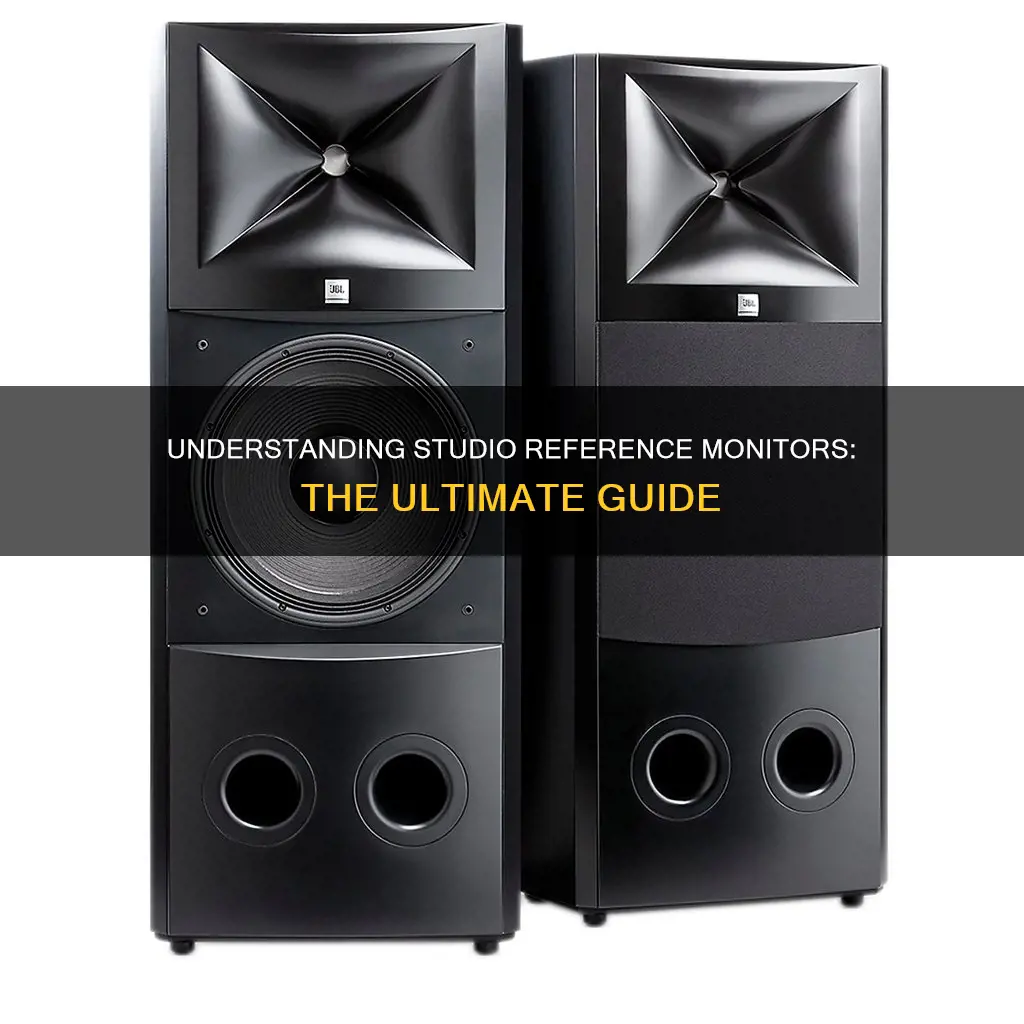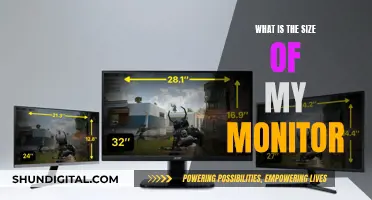
Studio reference monitors are an essential component of the mixing process for musicians and producers. They provide an accurate and detailed representation of the sound, allowing for critical decisions regarding EQ, compression, and other sound manipulation techniques. The market offers a wide range of options, from small nearfield monitors to larger tri-amped models, catering to various studio sizes and budgets. Active monitors, such as the KRK Rokit series, feature built-in amplifiers and simple equalisers, while passive monitors, though rarer, are valued by some engineers for their pristine sound. When choosing studio monitors, factors such as size, amplification, speaker layout, and frequency response should be considered to ensure they suit the studio space and provide a flat and uncoloured sound for effective mixing.
What You'll Learn

Active vs. passive studio monitors
Studio reference monitors, also known as studio speakers, are designed to provide an accurate and flat frequency response when recording, mixing, and mastering audio. They are used by professionals in recording studios, radio stations, and other audio environments.
Now, when it comes to active vs. passive studio monitors, here's a detailed comparison:
Active Studio Monitors
Active studio monitors, also known as powered monitors, have built-in amplifiers, making them simpler to use and set up. They are often preferred for their convenience and performance. Here are some key advantages of active monitors:
- They are typically more common and widely used, with many professional studios relying on active systems.
- They have all the necessary components built-in, includingsection-heading-ID-4crossovers, so you don't have to deal with extra rack gear.
- The internal amplifier is specifically matched to the speaker, ensuring optimal sonic performance.
- They offer optimised power amps for each driver, optimised driver-protection circuitry, and short, direct connections between amps and drivers.
- They may include simple equalizers and gain controls for adjusting frequency responses in your room.
Passive Studio Monitors
Passive studio monitors, on the other hand, require external amplifiers. While they may offer more flexibility, they also come with some drawbacks. Here are some key points about passive monitors:
- They are considered more traditional, as the recording industry grew up with passive monitoring systems.
- They are modular, allowing separate upgrades of the speakers and amplifier, which can be more cost-effective.
- They may be preferred by some engineers for their reputation for pristine sound, as the lack of onboard electronics may contribute to this.
In summary, the choice between active and passive studio monitors depends on your specific needs and preferences. If you want a plug-and-play solution that is reliable and accurate, active monitors are ideal. If you're willing to put in extra effort for more flexibility, passive monitors might be preferred.
Monitor Mount Screw Sizes: What Fits Best?
You may want to see also

Nearfield studio monitors
Studio reference monitors are an essential component of the mixing process, allowing producers and engineers to hear their tracks in intricate detail and make informed decisions when applying EQ, compression, and other sound manipulation techniques.
The Adam Audio T5V, KRK Rokit, and Yamaha HS5 are popular choices for nearfield studio monitors, offering precise sound reproduction and suitability for small spaces. These monitors are ideal for beginners or those seeking a balance of quality and affordability.
When choosing nearfield studio monitors, it is important to consider the size of the room, the listening distance, and the amount of acoustic treatment the room has received. Nearfield monitors are generally more room-agnostic and do not require as much design consideration as far-field monitors. However, their sound power capability is typically lower, making them unsuitable for producing concert-level sound pressure.
Performance Monitors: Maximizing Server Efficiency and Uptime
You may want to see also

Large studio monitors
Studio reference monitors are an essential tool for mix engineers, providing the detailed and precise audio needed to make critical decisions during the mixing process. These monitors deliver a flat frequency response, ensuring that the audio produced is an accurate representation of the original mix, without any colouration or enhancement. This accuracy is crucial, as it allows engineers to identify and fix any issues in the mix, ensuring that the final product will sound as intended across different playback systems.
When choosing large studio monitors, it is important to consider the size and acoustics of your space. While larger monitors can provide a more powerful sound, they may not be suitable for smaller recording studios or home studios due to their physical dimensions and the potential for acoustic issues. Additionally, the cost of large studio monitors can be a factor, as they tend to be more expensive than their smaller counterparts.
Some popular options for large studio monitors include the JBL LSR 6000 line and the Genelec 8000 series. These monitors offer advanced features such as sophisticated DSP (Digital Signal Processing) for room acoustic management and are designed to deliver accurate and detailed sound reproduction. When selecting studio monitors, it is always recommended to consider your specific needs, budget, and the acoustic characteristics of your studio space.
Monitors: Nintendo vs Unisystem, Size Comparison
You may want to see also

Studio monitor size and cabinet configuration
Studio monitors come in a variety of sizes and configurations, from small nearfield monitors to larger tri-amped models. The size and configuration of a studio monitor will depend on factors such as room size, music style, and budget.
For home studios, 5-inch speakers are generally recommended as they offer a good balance between low-frequency response and midrange and high-frequency clarity. Larger speakers can provide better low-frequency response, which is important for music styles such as EDM. However, smaller speakers may offer better midrange and high-frequency response due to their smaller size.
When choosing the size of studio monitors, it is also important to consider the amplifier configuration. Active studio monitors have built-in amplifiers, while passive monitors require external amplifiers. The amplifier configuration can impact the frequency response and sound reproduction of the monitors. For example, bi-amp configurations provide greater control over the frequency response, while tri-amp configurations offer the most flexibility and precision.
In addition to size and amplifier configuration, other factors such as driver quality, amplifier power, and speaker placement can also affect the sound quality of studio monitors. It is recommended to test different monitors in the intended room to find the best option.
Overall, the choice between different studio monitor sizes and configurations will depend on the specific needs and preferences of the user, as well as the characteristics of the room in which they will be used.
Monitoring Bandwidth Usage: Strategies for Effective Network Management
You may want to see also

Studio monitor management and monitoring headphones
Studio reference monitors are speakers that provide mix engineers with accurate details to make critical mixing decisions. Studio monitor management systems make switching between different sets of studio monitors or bypassing subwoofers easy. They also allow you to control and route your monitor sends, talkback system, and headphone mixes through a compact desktop unit. This gives you the flexibility to monitor your mix playback.
Studio Monitor Management
Studio monitor management systems make it easy to switch between different sets of studio monitors and bypass subwoofers. They also allow you to control and route your monitor sends, talkback system, and headphone mixes through a compact desktop unit. This gives you the flexibility to monitor your mix playback.
- Dangerous Music Monitor ST
- Mackie Big Knob series
- PreSonus Monitor Station V2 Desktop Monitor Controller
- Behringer CONTROL2USB High-End Studio Control
- Audient Nero Desktop Monitor Controller
- Heritage Audio R.A.M System 1000 Monitoring System
Monitoring Headphones
Headphones are a necessary part of any studio setup. They are used for live studio recording and mixing. When choosing headphones for the studio, you need to consider the intended application and your level of physical comfort with different styles.
- Audio-Technica ATH-M50x
- Beyerdynamic DT 770 PRO
- Sony MDR-7506
- Audio-Technica ATH-M20x
- Sennheiser HD 800 S
- Philips SHP9500
Best Places to Buy Computer Monitors in Salt Lake City
You may want to see also
Frequently asked questions
Studio reference monitors are speakers that are used in music production to provide an accurate representation of the audio being mixed. They are designed to have a flat frequency response, meaning that no part of the frequency spectrum is enhanced or reduced, so that the audio is heard in its true form. This allows producers and mix engineers to make informed decisions about the mix, such as reducing volume levels or applying EQ.
There are two main types of studio monitors: powered (or active) studio monitors, which have built-in amplifiers, and unpowered (or passive) studio monitors, which require external amplifiers. There are also different configurations such as nearfield studio monitors, which are typically smaller and designed for close-range listening, and larger tri-amped studio monitors found in upscale production houses.
Studio reference monitors are important because they allow producers and mix engineers to hear their tracks in intricate detail, enabling them to make informed decisions about EQ, compression, and other audio techniques. Good monitoring is a crucial component of the mixing process and can help ensure that the final mix translates well across different playback systems.
Some popular studio reference monitors include the Yamaha HS5, KRK Rokit, JBL 305P MKII, and Adam Audio T5V. These monitors offer a range of features, such as graphic EQ functions, room analysers, and ultra-clarity, making them suitable for various studio setups and audio engineering needs.







